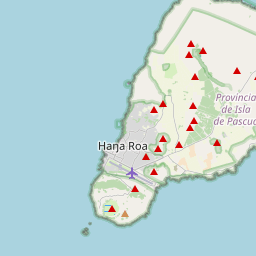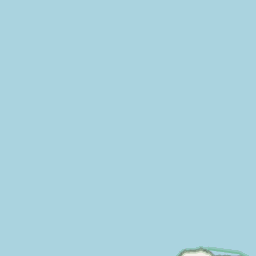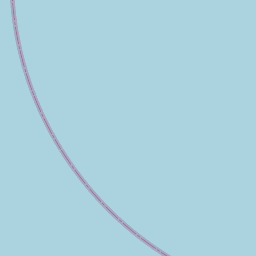








33 items
Hanga Roa (Spanish pronunciation: [ˈ(x)aŋɡa ˈro.a]; Rapa Nui: Haŋa Roa, Rapa Nui pronunciation: [ˈha.ŋa ˈɾo.a]) (Spanish: Bahía Larga) is the main town, harbour and seat of Easter Island, a municipality of Chile. It is located in the southern part of the island's west coast, in the lowlands between the extinct volcanoes of Terevaka and Rano Kau.
Rano Raraku is a volcanic crater formed of consolidated volcanic ash, or tuff, and located on the lower slopes of Terevaka in the Rapa Nui National Park on Easter Island in Chile. It was a quarry for about 500 years until the early eighteenth century, and supplied the stone from which about 95% of the island's known monolithic sculptures (moai) were carved. Rano Raraku is a visual record of moai design vocabulary and technological innovation, where 887 moai remain. Rano Raraku is in the World Heritage Site of Rapa Nui National Park and gives its name to one of the seven sections of the park.
Poike is one of the three main extinct volcanoes that form Rapa Nui (Easter Island), a Chilean island in the Pacific Ocean. At 370 metres above sea level, Poike's peak is the island's second-highest point after the peak of the extinct volcano Terevaka.
Ahu Akivi is a particular sacred place on the Chilean island of Rapa Nui (or Easter Island), looking out towards the Pacific Ocean. The site has seven moai, all of equal shape and size, and is also known as a celestial observatory that was set up around the 16th century. The site is located inland, rather than along the coast. Moai statues were considered by the early people of Rapa Nui as their ancestors or Tupuna that were believed to be the reincarnation of important kings or leaders of their clans. The Moais were erected to protect and bring prosperity to their clan and village.
The Biblioteca William Mulloy (Spanish for William Mulloy Library; in Rapa Nui, Hare Puka ko Wiliam Mulloy) is a research library administered by the Father Sebastian Englert Anthropological Museum on Rapa Nui (Easter Island) in Chilean Polynesia. Named for the late Dr. William Mulloy, an American archaeologist, the library’s collection focuses on Rapa Nui and Polynesian Studies, especially the prehistory, history, ethnology, archaeology, cultural anthropology, osteology and geology of Easter Island.
The Tahai Ceremonial Complex is an archaeological site on Rapa Nui (Easter Island) in Chilean Polynesia. Restored in 1974 by American archaeologist William Mulloy, Tahai comprises three principal ahu from north to south: Ko Te Riku (with restored eyes), Tahai, and Vai Ure. Visible in the distance from Tahai are two restored ahu at Hanga Kio'e, projects that Mulloy undertook in 1972. Like other Mulloy restoration projects at Ahu Akivi, the ceremonial village of Orongo and Vinapu, the ceremonial center at Tahai now constitutes an integral part of the Rapa Nui National Park, designated by UNESCO as a World Heritage site.
The Father Sebastian Englert Anthropological Museum is a museum in the town of Hanga Roa on Rapa Nui (Easter Island) in Chilean Polynesia. Named for the Bavarian missionary, Fr. Sebastian Englert, OFM Cap., the museum was founded in 1973 and is dedicated to the conservation of the Rapa Nui cultural patrimony.
website: http://www.museorapanui.cl/Inicio/
The Hanga Roa Stadium (Spanish: Estadio de Hanga Roa) is a football stadium in Hanga Roa, the capital of Easter Island, a territory of Chile. It is the home ground of the CF Rapa Nui, the Easter Island football team. The stadium holds about 1,000 people.
Hotel Hanga Roa, also known as Hanga Roa Eco Village & Spa, as of 2020 branded as Nayara Hangaroa, is a hotel in Hanga Roa, Easter Island, overlooking the bay on the Avenue Pont. The hotel was used extensively in the 1994 film Rapa Nui. In 1994, the hotel was purchased by the Panamericana hotel firm who extended the property with 10 fake thatched roofed bungalows, nine of which have three rooms. The 60 other rooms are located in the main building. Later, the hotel was acquired by Tanica hotels, owned by the Schliess family from mainland Chile. The Hito family, an extended family from Easter Island, occupied the premises for six months in 2010, claiming ancestral property rights. The hotel closed in 2011 for refurbishment and was projected to include a new museum and theatre, shopping complex, pool, tennis courts and other rooms. The hotel staff were mainly Rapa Nui locals, but the management was not from Easter Island. After a protracted conflict between the Hito family and the Schliess family, an agreement was reached in 2020. Under the agreement, property rights were transferred to the Hito family while the Tanica hotel group retained the right to exploit the hotel for 15 years. In 2020 the Costa Rican Nayara Resort group took control of the marketing.
Ahu Vinapu is an archaeological site on Rapa Nui (Easter Island) in Eastern Polynesia.
The Holy Cross Church (Spanish: Iglesia de la Santa Cruz), also known as the Catholic Church of Hanga Roa, or simply the Hanga Roa Church is a Catholic Church in Te Pito Te Henua Street in the city of Hanga Roa, the capital and greater city of the Easter Island, a Territory of Chile in the Pacific Ocean. The church was established in 1937, its first priest being Father Sebástian Englert.
Pu o Hiro (which means Hiro's Trumpet) is a stone on Easter Island that was used as a musical instrument by the ancient Rapa Nui. It is also known as Maea Puhi ("stone to blow" or "wind stone"). When blown through its main hole, it would produce a sound that resembled a trumpet. It was used to invoke Hiro, the deity of rain.
Rano Raraku è una cava di pietra situata presso l'omonimo cratere vulcanico sull'Isola di Pasqua in Cile che è stata la fonte della pietra utilizzata per le famose sculture monolitiche Moai che si trovano sparse intorno all'isola. Diversi Moai giacciono incompleti in questo luogo, così come molti che non furono sollevati a causa delle loro grandi dimensioni.
El Centro Cultural Katipare está ubicado en la localidad de Hanga Roa, en la comuna chilena de Isla de Pascua, Región de Valparaíso y lleva el nombre de Don Santiago "Katipare" Pakarati Rangitaki, en reconocimiento a su vasto trabajo como informante de gran cantidad de investigadores de la cultura, de distintos orígenes. En idioma rapanui fue denominado como Koro nui mo te maramarama, que se traduce como "Lugar de reunión para el conocimiento".[1]
Un hare paenga es un tipo de vivienda de la Isla de Pascua anterior a la llegada de los españoles.[1] Tenía forma de barca invertida muy alargada. La palabra hare significa ‘casa’ y paenga tiene el doble sentido de ‘piedras labradas’ y ‘familia extensa’, por lo que hare paenga puede significar tanto ‘casa sobre piedras labradas‘ como ‘casa de una familia extensa’.[2]
El Hospital Hanga Roa es un recinto hospitalario público perteneciente a la red asistencial del Servicio de Salud Metropolitano Oriente, ubicado en la capital de Isla de Pascua, Chile. Está orientado a la salud familiar, atención ambulatoria y hospitalaria de emergencia, y la atención secundaria de salud se resuelve mediante visitas periódicas o rondas organizadas de especialistas del servicio de salud. A su vez, el hospital está coordinado con la red asistencial continental para el traslado de pacientes.[1][2]
Street address: Simón Paoa S/N Isla de Pascua (from Wikidata)